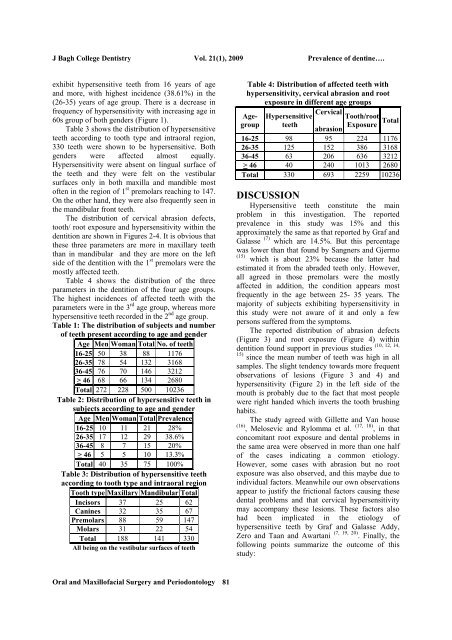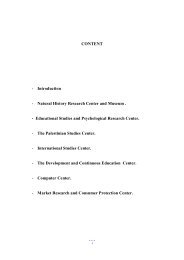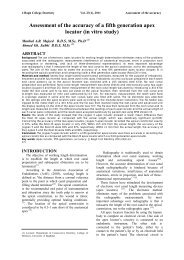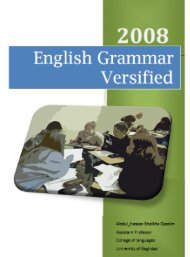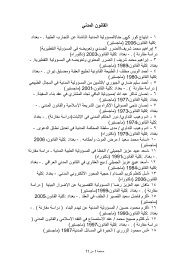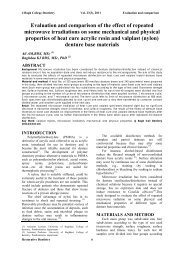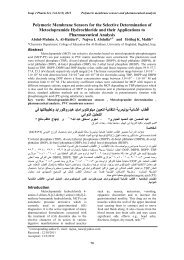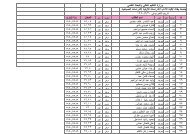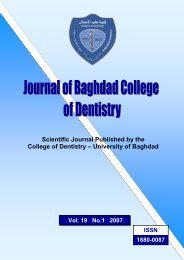Vol 21 No. 1
Vol 21 No. 1
Vol 21 No. 1
You also want an ePaper? Increase the reach of your titles
YUMPU automatically turns print PDFs into web optimized ePapers that Google loves.
J Bagh College Dentistry <strong>Vol</strong>. <strong>21</strong>(1), 2009 Prevalence of dentine….<br />
exhibit hypersensitive teeth from 16 years of age<br />
and more, with highest incidence (38.61%) in the<br />
(26-35) years of age group. There is a decrease in<br />
frequency of hypersensitivity with increasing age in<br />
60s group of both genders (Figure 1).<br />
Table 3 shows the distribution of hypersensitive<br />
teeth according to tooth type and intraoral region,<br />
330 teeth were shown to be hypersensitive. Both<br />
genders were affected almost equally.<br />
Hypersensitivity were absent on lingual surface of<br />
the teeth and they were felt on the vestibular<br />
surfaces only in both maxilla and mandible most<br />
often in the region of 1 st premolars reaching to 147.<br />
On the other hand, they were also frequently seen in<br />
the mandibular front teeth.<br />
The distribution of cervical abrasion defects,<br />
tooth/ root exposure and hypersensitivity within the<br />
dentition are shown in Figures 2-4. It is obvious that<br />
these three parameters are more in maxillary teeth<br />
than in mandibular and they are more on the left<br />
side of the dentition with the 1 st premolars were the<br />
mostly affected teeth.<br />
Table 4 shows the distribution of the three<br />
parameters in the dentition of the four age groups.<br />
The highest incidences of affected teeth with the<br />
parameters were in the 3 rd age group, whereas more<br />
hypersensitive teeth recorded in the 2 nd age group.<br />
Table 1: The distribution of subjects and number<br />
of teeth present according to age and gender<br />
Age Men Woman Total <strong>No</strong>. of teeth<br />
16-25 50 38 88 1176<br />
26-35 78 54 132 3168<br />
36-45 76 70 146 3<strong>21</strong>2<br />
> 46 68 66 134 2680<br />
Total 272 228 500 10236<br />
Table 2: Distribution of hypersensitive teeth in<br />
subjects according to age and gender<br />
Age Men Woman Total Prevalence<br />
16-25 10 11 <strong>21</strong> 28%<br />
26-35 17 12 29 38.6%<br />
36-45 8 7 15 20%<br />
> 46 5 5 10 13.3%<br />
Total 40 35 75 100%<br />
Table 3: Distribution of hypersensitive teeth<br />
according to tooth type and intraoral region<br />
Tooth type Maxillary Mandibular Total<br />
Incisors 37 25 62<br />
Canines 32 35 67<br />
Premolars 88 59 147<br />
Molars 31 22 54<br />
Total 188 141 330<br />
All being on the vestibular surfaces of teeth<br />
Table 4: Distribution of affected teeth with<br />
hypersensitivity, cervical abrasion and root<br />
exposure in different age groups<br />
Agegroup<br />
Hypersensitive<br />
teeth<br />
Cervical<br />
Tooth/root<br />
Exposure Total<br />
abrasion<br />
16-25 98 95 224 1176<br />
26-35 125 152 386 3168<br />
36-45 63 206 636 3<strong>21</strong>2<br />
> 46 40 240 1013 2680<br />
Total 330 693 2259 10236<br />
DISCUSSION<br />
Hypersensitive teeth constitute the main<br />
problem in this investigation. The reported<br />
prevalence in this study was 15% and this<br />
approximately the same as that reported by Graf and<br />
Galasse (7) which are 14.5%. But this percentage<br />
was lower than that found by Sangners and Gjermo<br />
(15)<br />
which is about 23% because the latter had<br />
estimated it from the abraded teeth only. However,<br />
all agreed in those premolars were the mostly<br />
affected in addition, the condition appears most<br />
frequently in the age between 25- 35 years. The<br />
majority of subjects exhibiting hypersensitivity in<br />
this study were not aware of it and only a few<br />
persons suffered from the symptoms.<br />
The reported distribution of abrasion defects<br />
(Figure 3) and root exposure (Figure 4) within<br />
(10, 12, 14,<br />
dentition found support in previous studies 15) since the mean number of teeth was high in all<br />
samples. The slight tendency towards more frequent<br />
observations of lesions (Figure 3 and 4) and<br />
hypersensitivity (Figure 2) in the left side of the<br />
mouth is probably due to the fact that most people<br />
were right handed which inverts the tooth brushing<br />
habits.<br />
The study agreed with Gillette and Van house<br />
(16) , Melosevic and Rylomma et al. (17, 18) , in that<br />
concomitant root exposure and dental problems in<br />
the same area were observed in more than one half<br />
of the cases indicating a common etiology.<br />
However, some cases with abrasion but no root<br />
exposure was also observed, and this maybe due to<br />
individual factors. Meanwhile our own observations<br />
appear to justify the frictional factors causing these<br />
dental problems and that cervical hypersensitivity<br />
may accompany these lesions. These factors also<br />
had been implicated in the etiology of<br />
hypersensitive teeth by Graf and Galasse Addy,<br />
Zero and Taan and Awartani (7, 19, 20) . Finally, the<br />
following points summarize the outcome of this<br />
study:<br />
Oral and Maxillofacial Surgery and Periodontology 81


